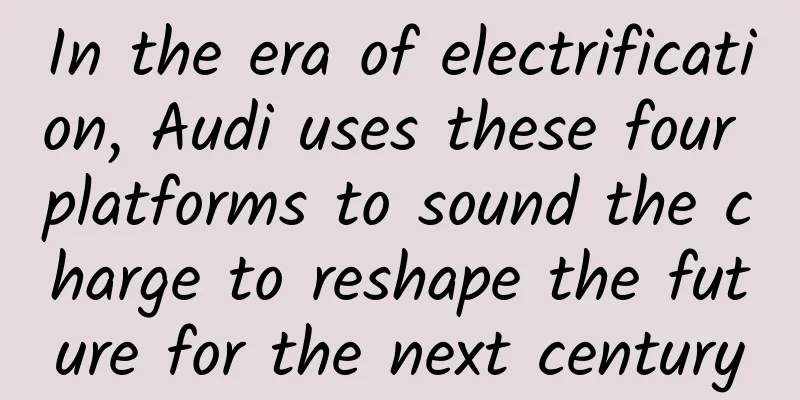In the era of electrification, Audi uses these four platforms to sound the charge to reshape the future for the next century

|
110 years ago, due to huge differences between the board of directors and the supervisory board, August Horch decided to leave the Horch Automobile Company he founded and start all over again in Zwickau, a small town upstream of the Mulde River. 75 years later, Steve Jobs, the founder of Apple, was kicked out by the "Sculley the Sugar Seller" of the board of directors. But he returned to Cupertino, California as a savior several years later. History is repeating itself, and the ending is roughly the same. Just like the inspirational stories that are repeatedly told by the Chinese, the powerful people who can truly influence the course of history all possess an incredible "distorted reality force field", and the meandering rivers in reality will become straight because of their determination. Compared with Jobs, who ran away, returned to prison and then revived Apple, Horch a hundred years ago was obviously more determined. The only thing that made him hesitant was the name of the new company - his own name, that is, the two words "Horch", had been registered many times, so what should the new company be called? "Why not Audi?" said the son of Horch's partner Fickencher. Audi is Latin, and its meaning is similar to Horch's in German, both of which mean "listen". Listen, it is with this sound that a century-old legend about Audi begins to roar around the world. Electrification: Audi's new starting point for the next century Entering a new era, Audi, which has been running for a century since ancient times, has decided to start its own electrification journey, including continuing to promote the electrification of models, continuously expanding the model portfolio, and accelerating the transformation into an electric vehicle manufacturer. As Bram Schot, Chairman of the Board of Management of Audi AG, pointed out: "The future is electric. The Audi brand is leading the trend of electric mobility and driving the entire automotive industry to develop electric vehicles suitable for everyday use." This firm decision is no less important than the one made by brand founder Horch 110 years ago. From a general perspective, the transition from internal combustion engines to electric motors is not only related to the fate of the Audi brand, but also closely related to the world. In Audi's plan, by 2025, the carbon footprint of Audi products throughout their life cycle will be reduced by 30% compared to 2015. In order to achieve this, Audi will launch 30 electric models during this cycle, 20 of which will be pure electric models. Of course, while Audi has a long-term vision and a keen insight, the impact of policies is also a factor that cannot be ignored. In the EU's 2030 carbon dioxide emission target proposal, the EU requires automakers to reduce their average carbon dioxide emissions by another 30% from 2021. Obviously, in this goal, the electrification of automobiles has become the only feasible solution. In fact, it was also driven by this policy that Europe sold 408,000 new energy vehicles last year, a year-on-year increase of 33%. Benefiting from the dual influence of policy and market, the Chinese market, as a battleground for global new energy vehicles, has also ushered in a leapfrog development. According to statistics from the China Association of Automobile Manufacturers, my country's sales of new energy vehicles just exceeded 10,000 units in 2012, but by 2018, sales had reached a huge 1.256 million units, a hundred-fold increase compared to 2012. Last year, the global sales of automobiles totaled 95.6 million. According to the goal reached in the Boao Consensus of the World New Energy Vehicle Conference, the global market share of new energy vehicles will reach 50% in 2035. In other words, even with the most pessimistic trend, the global sales of new energy vehicles will exceed 50 million by then. From the European Union to China and then to the United States, the blueprint for the new energy vehicle industry has been clearly outlined. The duck knows first when the river water warms in spring. On the end of the industry, whether it is the macro situation or the micro details, everything is in the foresight and enterprising spirit of the ambitious industry giants. Take Audi as an example. It had already started planning for electrification at the very beginning of the industry. In the 2012 Le Mans 24 Hours, the Audi car with the e-tron logo won the championship again. At that time, the wave of electrification had not yet taken off. As we all know, the word e-tron has become Audi's exclusive term for electric vehicles in the future, and has become a concrete expression of Audi's efforts in automobile electrification. In the historical process facing the next hundred years, Audi e-tron, as a node, undoubtedly has a striking symbolic significance. Comprehensive advancement: Audi e-tron's four major platforms A century of development begins with a sense of urgency. Facing the coming decade, Audi has injected a new platform plan into its electrification determination. From the existing Audi e-tron SUV built on the longitudinal modular platform (MLB evo) to the PPE platform jointly built with Porsche to enter the luxury market, Audi will launch four new platforms in the next decade, namely the Audi e-tron, the Audi e-tron GT high-performance electric vehicle based on the J1 high-performance platform developed by Porsche, the entry-level Audi Q4 e-tron built on the MEB modular electric platform, and the high-end electric vehicle platform (PPE) jointly designed and developed with Porsche, covering all types of products from compact to high-performance vehicle product portfolios to meet the needs of users from all walks of life for Audi electric vehicles. As Audi's first pure electric model, the e-tron's body size is between the Q5 and Q7. Its appearance not only marks Audi's determination to fully enter the era of electrification, but also firmly positions Audi's brand at the high end in terms of product positioning. When the industry generally regards Audi e-tron as the most powerful competitor of Tesla Model X, Audi's first attempt in the era of electrification has also had its first response. The record of more than 20,000 global orders has also made Audi's opponents begin to re-examine this big brother of traditional oil vehicles. In other words, whether it is a fuel car or an electric car, Audi's models are inheriting its own noble bloodline - no matter what, first of all, it must be an Audi. For the Audi brand, it would be a terrible disaster if there was no iconic high-performance sports car. Can you imagine how incredible Audi would be without the R8? Therefore, even in the field of electric vehicles, Audi needs a car that represents extreme speed. Obviously, the Audi e-tron GT concept car, which debuted at the Los Angeles Auto Show last year, was born for this mission. There is no doubt that its mass production in the near future will rewrite the definition of high performance in the electric vehicle industry. As an "iconic car" of Audi, the Audi e-tron GT, developed based on the Porsche J1 high-performance platform, is equipped with two permanent magnet synchronous motors (PSM). With 590 horsepower, it can accelerate from a standstill to 100 km/h in just 3.5 seconds. According to the WLTP standard, the cruising range exceeds 400 kilometers. The standard 800 V charging system can be fully charged to 80% of the power in just 20 minutes. As a sports car, the Audi e-tron GT concept car has a typical GT proportion with a length, width and height of 4.96 meters, 1.96 meters and 1.38 meters respectively. In addition, in addition to the large amount of composite materials used in the body to reduce weight, it is also equipped with Audi's famous quattro full-time four-wheel drive system. More importantly, compared with many PPT models that remain on the drawing board, this Audi model is quite complete and is close to mass production level. Facing a broader consumer market, Audi has come up with a Q4 e-tron model that is proud of its compact car. Through the MEB platform shared with the Volkswagen Group, Audi's model has a relatively low price while still having a distinct Audi style, including a redesigned dashboard structure. The stacking of many high-tech elements still makes this compact SUV stand out. Although the Q4 e-tron is similar to the Q3 in appearance, thanks to the 2.76-meter wheelbase, its interior size is comparable to the traditional Q5 model. In Audi's view, although this is an entry-level model, its charming design, high-quality interior workmanship and top-level operating system will be indispensable. Again, no matter what, it must be an Audi first. This is like a promise. No matter whether it is a model that has already been launched, a model that is about to be completed, or a luxury car built on the Audi PPE platform that redefines the standards for luxury electric vehicles, Audi always takes "this is an Audi first" as its basic starting point. As a high-end electric vehicle platform jointly designed and developed with Porsche, its pedigree has guaranteed its nobility. Although the design of this Audi luxury electric vehicle, which is still on the PPE research and development platform, is still very incomplete, the media that have witnessed its initial appearance at the Munich media conference have to describe it as stunning. In a word, if it goes into mass production, the BOSS-level dignity and excellence will be fully reflected. If Audi's launch of four electric vehicle-specific platforms at once is an ambition, then Audi's heavy investment in electric charging piles is the fundamental support for this ambition. Tesla is indeed a pioneer in the construction of electric charging piles, but with the emergence of various problems, its construction progress and the constantly changing charging rules, to a certain extent, reflect its lack of follow-up. In comparison, Audi and the Volkswagen Group behind it appear to be more steady and cautious, neither issuing various empty promises to users for marketing purposes, nor making radical or even unrealistic plans for the market. As early as 2017, Volkswagen Group, together with Audi, Porsche, BMW, Daimler and Ford, created the European DC fast charging network Ionity. It is reported that by 2020, this network will complete the construction of 400 high-power charging (HPC) stations in 25 countries around the world. It can fully charge an electric car in 20 minutes through 350 kilowatts of high-power charging, and it is expected to build one every less than 120 kilometers, which is as convenient as a traditional gas station. In the future, in Audi's European base, this network will be able to provide charging services to customers using more than 110,000 public charging points covered by 220 providers, accounting for 80% of all charging stations in Europe. There is no doubt that in the face of this data, the pressure on Tesla's existing charging piles will be further amplified. Of course, in order to meet the diverse needs of users, plug-in hybrid power, as an important part of Audi's electrification strategy, is also highly anticipated by users. Taking the four plug-in hybrid models A7, A8, Q5 and Q7 that will be launched in China next year as an example, their pure electric range is more than 40 km. Coupled with the standard 3.0 V6 TFSI engine (equipped with A8 and Q7) and 2.0 TFSI engine (equipped with A7 Sportback and Q5), the power performance of Audi's plug-in hybrid models always remains ahead in similar competition. The uncompromising driving experience will also reflect its luxurious texture in terms of control, quality and other details. Yes, no matter what kind of power it uses, this must first be an Audi. Listen, Audi's Chinese voice The importance of the Chinese market to Audi is self-evident. Chinese elements are not uncommon at Audi's headquarters in the German town of Ingolstadt. On the back wall of the meeting room of its design department, there is a background board covering the entire wall, which depicts the car usage preferences of users in China and the United States. From the details of the interior decoration to the habit of placing mineral water or baseball bats, the car usage habits of Audi users on both sides of the ocean are circled in red, which reminds Audi's designers how to get to know users and reach their hearts when designing. Next to this wall, there is also a booklet that directly illustrates the car usage habits of Chinese and American users, so that designers can always remind themselves of their mission and goals when needed. In terms of the aesthetics and even culture of cars, the minds of Chinese users are still in a stage of rapid development. When Audi design meets Chinese aesthetics, what force makes the two blend seamlessly? In other words, the design of each generation of models is like a continuous river. Why can the water that the designer casually scoops up always touch people's hearts? In an interview at Audi headquarters, an Audi designer said that the design of a car often starts seven years ago. During this long period of time, how to ensure that the car is still fashionable and eye-catching when it is on the road is indeed an extremely difficult test for designers. However, being an Audi designer has such an advantage - big brands often have more design resources and more trial and error opportunities, and can select the design that best represents the future from countless design options. In fact, how to make a design from seven years ago still look brilliant and creative today is a kind of power, a power about aesthetic interpretation - and large companies often have more equal interpretation ability in this power. This is why the designs of traditional luxury brands are more likely to touch your heart and inspire your admiration for beauty. This phenomenon is indeed not accidental, and behind it are countless rejected design drafts over thousands of days and nights. Just like Audi, there are design centers in Germany, the United States, and China, with so many design masters expressing their inspiration, and only presenting you with the most beautiful side. For example, in the design of the central control panel of the Audi e-tron, there is no attempt to save trouble by using a large, abrupt screen to cover up the laziness or weakness in design. Instead, it divides and conquers, using two screens with different functions and a knob with excellent damping to complete a series of inherited operating experiences, while maintaining "low energy consumption and high intelligence" and taking into account the superior control that a luxury car should have. That’s right, making a knob with a delicate damping feel is much more difficult than making a large screen - don’t you think that putting a whole tablet in the center control area seems to lack design appeal? Excellent design, perfect details, and surging power, even after a hundred years of baptism, Audi does have its own unparalleled persistence in quality. It is precisely because of this belief that Audi has achieved 20 years of glory in China. Back in the autumn of 1999, when the first Audi A6 model rolled off the production line in Changchun, China, Audi's legend began to make a name for itself in China's high-end automobile market. In fact, the generation that grew up with the reform and opening up of the Republic, and who are now the backbone of society, still remember vividly the "bang" sound when the Audi A6 door closed in the original commercial, and their hearts are still beating fast. Just like Japan's Sony sparked the Chinese people's initial desire for home appliances, Audi also used this "bang" to tell the Chinese what the standard is for measuring whether a car can be called luxurious. In this sense, the “bang” that Audi sounded in the Chinese market in 1999 did indeed inspire the future and also opened the golden age of Audi in the Chinese high-end automobile market. Today, as that generation of Chinese people step into success, Audi has ushered in a new moment of assembly. The charge for Audi to reconstruct the future of electrification has been sounded in the Chinese market. Currently, the two electric models produced by Audi in China are A6 L e-tron and Q2 L e-tron. By next year, Audi e-tron will also be produced domestically. There is no doubt that in the Chinese market, in the era of electrification, Audi's "bang" that defines the luxury car experience will continue to inspire imagination. "Bang", listen, this is the sound, the electrified Audi is still inspiring the future. As a winner of Toutiao's Qingyun Plan and Baijiahao's Bai+ Plan, the 2019 Baidu Digital Author of the Year, the Baijiahao's Most Popular Author in the Technology Field, the 2019 Sogou Technology and Culture Author, and the 2021 Baijiahao Quarterly Influential Creator, he has won many awards, including the 2013 Sohu Best Industry Media Person, the 2015 China New Media Entrepreneurship Competition Beijing Third Place, the 2015 Guangmang Experience Award, the 2015 China New Media Entrepreneurship Competition Finals Third Place, and the 2018 Baidu Dynamic Annual Powerful Celebrity. |
>>: Yin Yuan from Suning Sports: Television is still an indispensable companion in our lives
Recommend
Sogou advertising efficient delivery case study!
01. Insights into the thermal insulation material...
How does Shanda Games achieve automatic management of remote servers?
This article is the on-site dry goods of WOT2016 ...
Ditch the milk and drink "plant milk"? Don't do it yet!
|||| Compiled by New Media Editor Fang Yongzhen T...
How much does it cost to develop a watch applet in Alxa League?
How much does it cost to develop the Alxa League ...
Samsung's mobile phone business is hit hard, and the empire may be coming to an end
The gradual collapse of the Samsung empire has fin...
The sixth anniversary of the "China Sky Eye"! What achievements has this unique spherical radio telescope made?
On September 25, 2016, the Five-hundred-meter Ape...
Detailed explanation of the Glide cache mechanism principle for advanced Android source code
[[420787]] This article is reprinted from the WeC...
China Life Sciences and Healthcare Industry Survey Results: Current Status and Outlook in 2023
How will your company's business performance ...
APP operation and promotion: How to attract 20,000 new users in January at 0 cost?
Some time ago, I wrote an article titled "In...
Artemisinin, an anti-malarial drug
Since ancient times, humans have been waging a lo...
Among the "carcinogenic foods" that are circulating wildly in the circle of friends, which one can really cause cancer?
Do you often see this kind of articles in your ci...
The speed of approval for the sixth new energy vehicle license plate is questioned as many automakers compete for it
Fighting for the sixth new energy vehicle license...
China Mobile APP Advertising Fraud Analysis Report
PC is disappearing from our daily life scenes at ...
How to use the WeChat homestay mini program function for booking and checking in homestays?
Some time ago, many customers consulted the edito...
Nissan's new car will launch maintenance reminder function to test car networking
[Global Network Comprehensive Report] According t...









